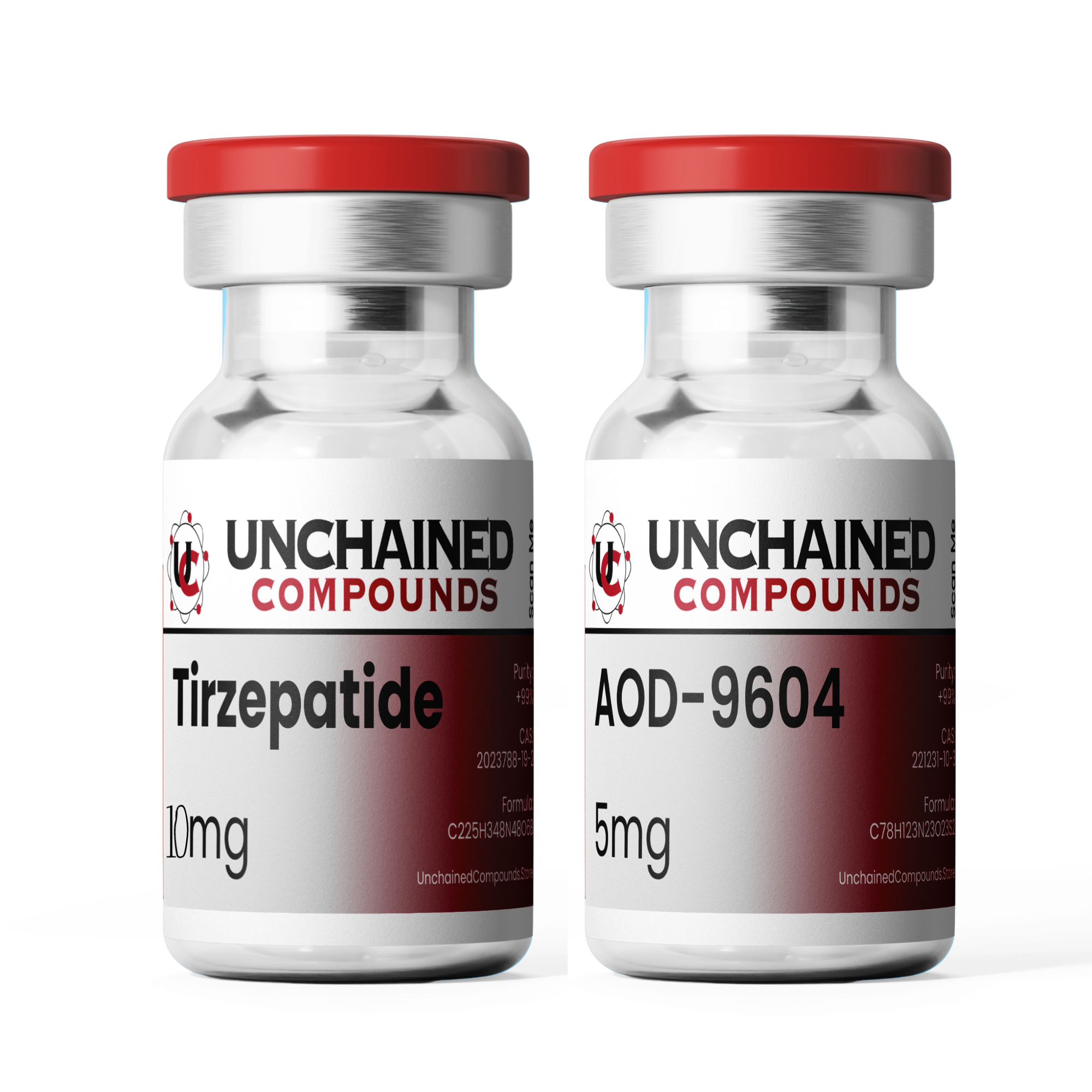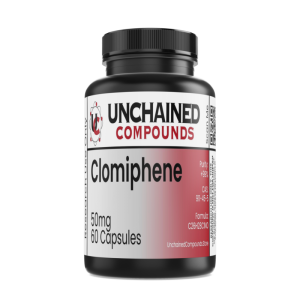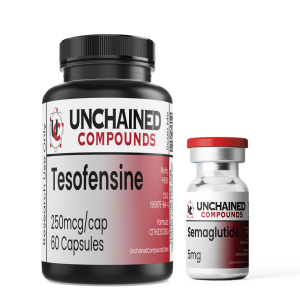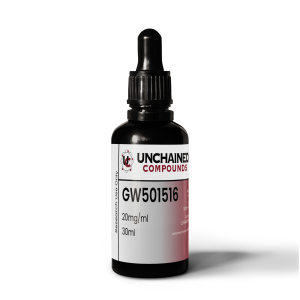Description







Tirzepatide is a synthetic derivative of gastric inhibitory polypeptide (GIP) that has simultaneous glucagon-like peptide-1 (GLP-1) functionality as well. This combination allows Tirzepatide to lower blood glucose levels, increase insulin sensitivity, boost feelings of satiety, and accelerate weight loss.
AOD9604 is a modified version of the hGH fragment 176-191 peptide (contains a di-sulfide bridge) and thus a derivative of human growth hormone (hGH). Originally developed as a lipolytic (fat burning) compound, AOD9604 has shown benefit in studies of heart disease, osteoarthritis/cartilage repair, and metabolic syndrome. AOD9604 stimulates lipolysis (the breakdown or destruction of fat) and inhibits lipogenesis in animal studies.
Specifications
Tirzepatide
- Chemical Formula: C225H348N48O68
- Molecular Mass: 4813
- Synonyms: Tirzepatide (LY3298176) 2023788-19-2 Tirzepatide GTPL11429
- PubChem: 156588324
- Total Amount of the Active Ingredient: 10mg (1 vial)
- Shelf Life: 36 months
AOD-9604
- Chemical Formula: C78H123N23O23S2
- Molecular Mass: 1815.12g/mol
- Synonyms: AOD-9604; AOD 9604; AOD9604
- CAS Number: 221231-10-3
- PubChem: 16131447
- Total Amount of the Active Ingredient: 5 mg (1 vial)
- Shelf Life: 36 months
Research Studies
Tirzepatide Once Weekly for the Treatment of Obesity
Abstract
BACKGROUND
Obesity is a chronic disease that results in substantial global morbidity and mortality. The efficacy and safety of tirzepatide, a novel glucose-dependent insulinotropic polypeptide and glucagon-like peptide-1 receptor agonist, in people with obesity are not known.
METHODS
In this phase 3 double-blind, randomized, controlled trial, we assigned 2539 adults with a body-mass index (BMI; the weight in kilograms divided by the square of the height in meters) of 30 or more, or 27 or more and at least one weight-related complication, excluding diabetes, in a 1:1:1:1 ratio to receive once-weekly, subcutaneous tirzepatide (5 mg, 10 mg, or 15 mg) or placebo for 72 weeks, including a 20-week dose-escalation period. Coprimary end points were the percentage change in weight from baseline and a weight reduction of 5% or more. The treatment-regimen estimand assessed effects regardless of treatment discontinuation in the intention-to-treat population.
RESULTS
At baseline, the mean body weight was 104.8 kg, the mean BMI was 38.0, and 94.5% of participants had a BMI of 30 or higher. The mean percentage change in weight at week 72 was −15.0% (95% confidence interval [CI], −15.9 to −14.2) with 5-mg weekly doses of tirzepatide, −19.5% (95% CI, −20.4 to −18.5) with 10-mg doses, and −20.9% (95% CI, −21.8 to −19.9) with 15-mg doses and −3.1% (95% CI, −4.3 to −1.9) with placebo (P<0.001 for all comparisons with placebo). The percentage of participants who had weight reduction of 5% or more was 85% (95% CI, 82 to 89), 89% (95% CI, 86 to 92), and 91% (95% CI, 88 to 94) with 5 mg, 10 mg, and 15 mg of tirzepatide, respectively, and 35% (95% CI, 30 to 39) with placebo; 50% (95% CI, 46 to 54) and 57% (95% CI, 53 to 61) of participants in the 10-mg and 15-mg groups had a reduction in body weight of 20% or more, as compared with 3% (95% CI, 1 to 5) in the placebo group (P<0.001 for all comparisons with placebo). Improvements in all prespecified cardiometabolic measures were observed with tirzepatide. The most common adverse events with tirzepatide were gastrointestinal, and most were mild to moderate in severity, occurring primarily during dose escalation. Adverse events caused treatment discontinuation in 4.3%, 7.1%, 6.2%, and 2.6% of participants receiving 5-mg, 10-mg, and 15-mg tirzepatide doses and placebo, respectively.
CONCLUSIONS
In this 72-week trial in participants with obesity, 5 mg, 10 mg, or 15 mg of tirzepatide once weekly provided substantial and sustained reductions in body weight. (Supported by Eli Lilly; SURMOUNT-1 ClinicalTrials.gov number, NCT04184622.)
Tirzepatide: A Systematic Update
Abstract
Tirzepatide is a new molecule capable of controlling glucose blood levels by combining the dual agonism of Glucose-Dependent Insulinotropic Polypeptide (GIP) and Glucagon-Like Peptide-1 (GLP-1) receptors. GIP and GLP1 are incretin hormones: they are released in the intestine in response to nutrient intake and stimulate pancreatic beta cell activity secreting insulin. GIP and GLP1 also have other metabolic functions. GLP1, in particular, reduces food intake and delays gastric emptying. Moreover, Tirzepatide has been shown to improve blood pressure and to reduce Low-Density Lipoprotein (LDL) cholesterol and triglycerides. Tirzepatide efficacy and safety were assessed in a phase III SURPASS 1-5 clinical trial program. Recently, the Food and Drug Administration approved Tirzepatide subcutaneous injections as monotherapy or combination therapy, with diet and physical exercise, to achieve better glycemic blood levels in patients with diabetes. Other clinical trials are currently underway to evaluate its use in other diseases. The scientific interest toward this novel, first-in-class medication is rapidly increasing. In this comprehensive and systematic review, we summarize the main results of the clinical trials investigating Tirzepatide and the currently available meta-analyses, emphasizing novel insights into its adoption in clinical practice for diabetes and its future potential applications in cardiovascular medicine.
Abstract
Background: Weight reduction is essential for improving health outcomes in people with obesity and type 2 diabetes. We assessed the efficacy and safety of tirzepatide, a glucose-dependent insulinotropic polypeptide and glucagon-like peptide-1 receptor agonist, versus placebo, for weight management in people living with obesity and type 2 diabetes.
Methods: This phase 3, double-blind, randomised, placebo-controlled trial was conducted in seven countries. Adults (aged ≥18 years) with a body-mass index (BMI) of 27 kg/m2 or higher and glycated haemoglobin (HbA1c) of 7-10% (53-86 mmol/mol) were randomly assigned (1:1:1), using a computer-generated random sequence via a validated interactive web-response system, to receive either once-weekly, subcutaneous tirzepatide (10 mg or 15 mg) or placebo for 72 weeks. All participants, investigators, and the sponsor were masked to treatment assignment. Coprimary endpoints were the percent change in bodyweight from baseline and bodyweight reduction of 5% or higher. The treatment-regimen estimand assessed effects regardless of treatment discontinuation or initiation of antihyperglycaemic rescue therapy. Efficacy and safety endpoints were analysed with data from all randomly assigned participants (intention-to-treat population). This trial is registered with ClinicalTrials.gov, NCT04657003.
Findings: Between March 29, 2021, and April 10, 2023, of 1514 adults assessed for eligibility, 938 (mean age 54·2 years [SD 10·6], 476 [51%] were female, 710 [76%] were White, and 561 [60%] were Hispanic or Latino) were randomly assigned and received at least one dose of tirzepatide 10 mg (n=312), tirzepatide 15 mg (n=311), or placebo (n=315). Baseline mean bodyweight was 100·7 kg (SD 21·1), BMI 36·1 kg/m2 (SD 6·6), and HbA1c 8·02% (SD 0·89; 64·1 mmol/mol [SD 9·7]). Least-squares mean change in bodyweight at week 72 with tirzepatide 10 mg and 15 mg was -12·8% (SE 0·6) and -14·7% (0·5), respectively, and -3·2% (0·5) with placebo, resulting in estimated treatment differences versus placebo of -9·6% percentage points (95% CI -11·1 to -8·1) with tirzepatide 10 mg and -11·6% percentage points (-13·0 to -10·1) with tirzepatide 15 mg (all p<0·0001). More participants treated with tirzepatide versus placebo met bodyweight reduction thresholds of 5% or higher (79-83% vs 32%). The most frequent adverse events with tirzepatide were gastrointestinal-related, including nausea, diarrhoea, and vomiting and were mostly mild to moderate in severity, with few events leading to treatment discontinuation (<5%). Serious adverse events were reported by 68 (7%) participants overall and two deaths occurred in the tirzepatide 10 mg group, but deaths were not considered to be related to the study treatment by the investigator.
Interpretation: In this 72-week trial in adults living with obesity and type 2 diabetes, once-weekly tirzepatide 10 mg and 15 mg provided substantial and clinically meaningful reduction in bodyweight, with a safety profile that was similar to other incretin-based therapies for weight management.
Abstract
Objective:To observe the chronic effects of human growth hormone (hGH) and AOD9604 (a C-terminal fragment of hGH) on body weight, energy balance, and substrate oxidation rates in obese (ob/ob) and lean C57BL/6Jmice. In vitro assays were used to confirm whether the effects of AOD9604 are mediated through the hGH receptor, and if this peptide is capable of cell proliferation via the hGH receptor.
Method:Obese and lean mice were treated with hGH, AOD or saline for 14 days using mini-osmotic pumps. Body weight, caloric intake, resting energy expenditure, fat oxidation, glucose oxidation, and plasma glucose, insulin and glycerol were measured before and after treatment. BaF-BO3 cells transfected with the hGH receptor were used to measure in vitro 125I-hGH receptor binding and cell proliferation.
Results:Both hGH and AOD significantly reduced body weight gain in obese mice. This was associated with increased in vivo fat oxidation and increased plasma glycerol levels (an index of lipolysis). Unlike hGH, however, AOD9604 did not induce hyperglycaemia or reduce insulin secretion. AOD9604 does not compete for the hGH receptor and nor does it induce cell proliferation, unlike hGH.
Conclusions:Both hGH and its C-terminal fragment reduce body weight gain, increase fat oxidation, and stimulate lipolysis in obese mice, yet AOD9604 does not interact with the hGH receptor. Thus, the concept of hGH behaving as a pro-hormone is further confirmed. This data shows that fragments of hGH can act in a manner novel to traditional hGH-stimulated pathways.
Abstract
Both human GH (hGH) and a lipolytic fragment (AOD9604) synthesized from its C-terminus are capable of inducing weight loss and increasing lipolytic sensitivity following long-term treatment in mice. One mechanism by which this may occur is through an interaction with the beta-adrenergic pathway, particularly with the beta(3)-adrenergic receptors (beta(3)-AR). Here we describe how hGH and AOD9604 can reduce body weight and body fat in obese mice following 14 d of chronic ip administration. These results correlate with increases in the level of expression of beta(3)-AR RNA, the major lipolytic receptor found in fat cells. Importantly, both hGH and AOD9604 are capable of increasing the repressed levels of beta(3)-AR RNA in obese mice to levels comparable with those in lean mice. The importance of beta(3)-AR was verified when long-term treatment with hGH and AOD9604 in beta(3)-AR knock-out mice failed to produce the change in body weight and increase in lipolysis that was observed in wild-type control mice. However, in an acute experiment, AOD9604 was capable of increasing energy expenditure and fat oxidation in the beta(3)-AR knock-out mice. In conclusion, this study demonstrates that the lipolytic actions of both hGH and AOD9604 are not mediated directly through the beta(3)-AR although both compounds increase beta(3)-AR expression, which may subsequently contribute to enhanced lipolytic sensitivity.
Metabolic studies of a synthetic lipolytic domain (AOD9604) of human growth hormone
Abstract
A synthetic analogue (AOD9604) of the lipolytic domain of human growth hormone (hGH) has been studied for its metabolic actions in obese Zucker rats. Daily treatment with an oral dose of AOD9604 of 500 microg/kg body weight for 19 days reduced over 50% (15.8 +/- 0.6 vs. 35.6 +/- 0.8 g) body weight gain of the animals in comparison with the control. The adipose tissues of the AOD9604–treated animals were found to have an increase in lipolytic activity. In contrast to chronic treatment with intact hGH, chronic treatment with AOD9604 showed no adverse effect on insulin sensitivity of the animals, as demonstrated with euglycemic clamp techniques. The results in the present study suggest that the analogue of the hGH lipolytic domain may have the potential to be developed into an orally usable and safe therapeutic agent for obesity.
Disclaimer
The information provided above is not intended to substitute medical advice, diagnosis, or treatment. Should you have any questions regarding a medical condition, seek the advice of your physician or a qualified healthcare provider. In no case should medical advice be disregarded or delayed because of what you have read or seen. We bear no responsibility or liability for your use of any of our research compounds and products. Please note that they are being sold for research purposes ONLY. We do NOT condone any personal use.
NOTE: In some cases wherein the assigned top colors are out of stock, a different top color will be used to ensure that your order will not be delayed. Should you need assistance identifying the peptide vial that you received, please send us an email at support@unchainedcompounds.store.
ALL ARTICLES AND PRODUCT INFORMATION PROVIDED ON THIS WEBSITE ARE FOR INFORMATIONAL AND EDUCATIONAL PURPOSES ONLY.
The products offered on this website are intended for in-vitro studies only. In-vitro studies (Latin: “in glass”) are performed outside the body. These products are not medicines or drugs and have not been approved by the FDA to prevent, treat, or cure any medical condition, ailment, or disease. Bodily introduction of any kind into humans or animals is strictly forbidden by law.







